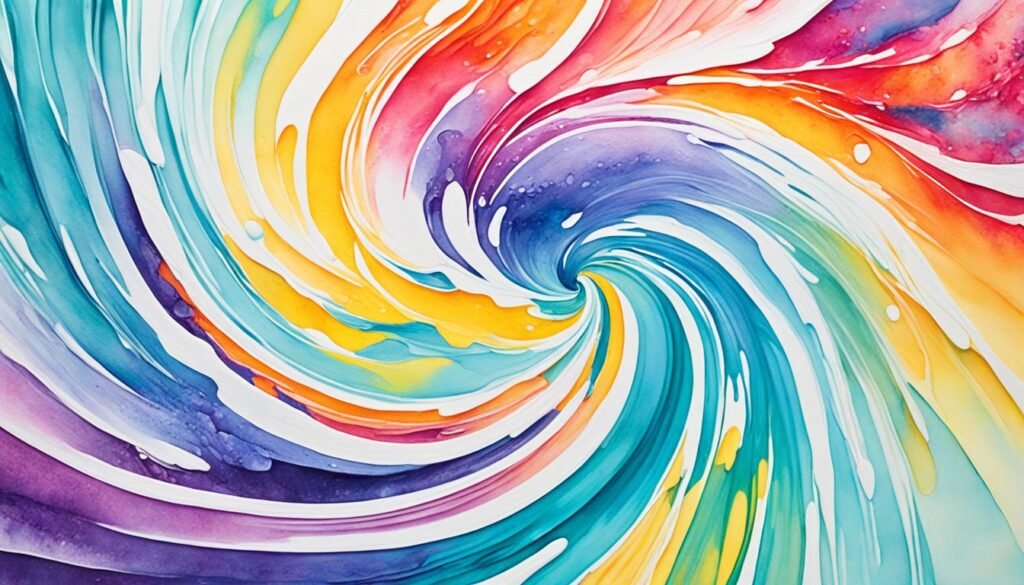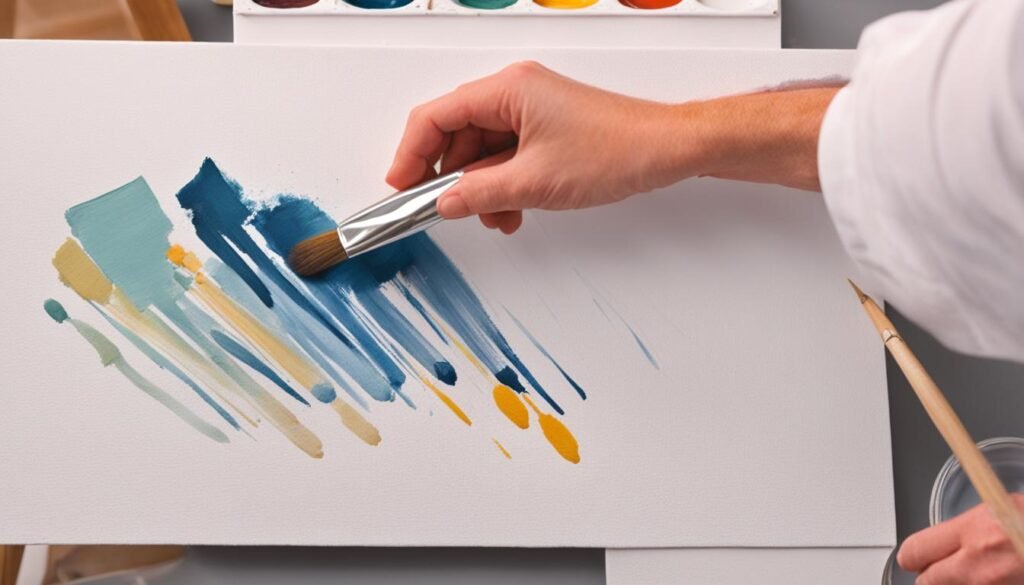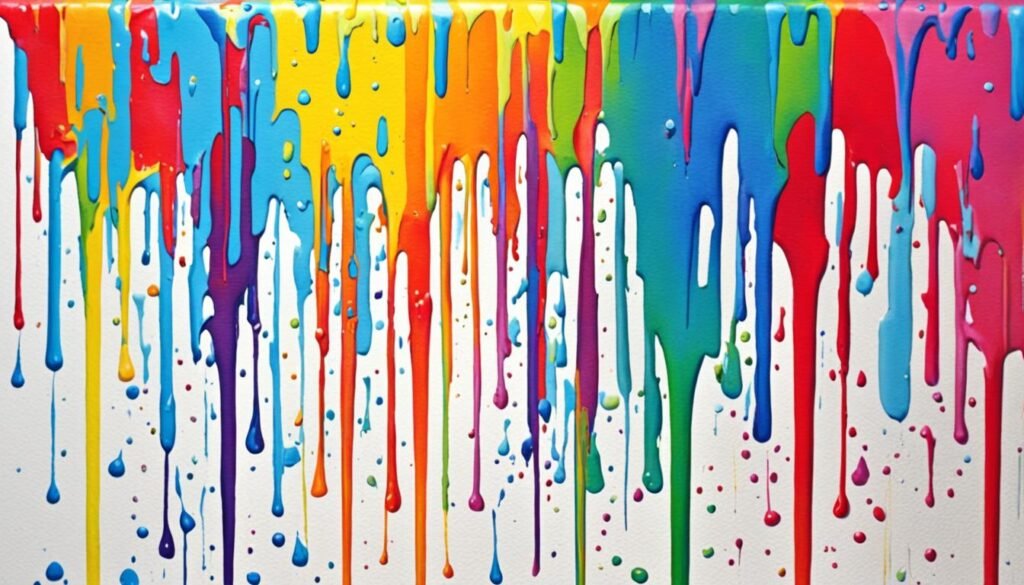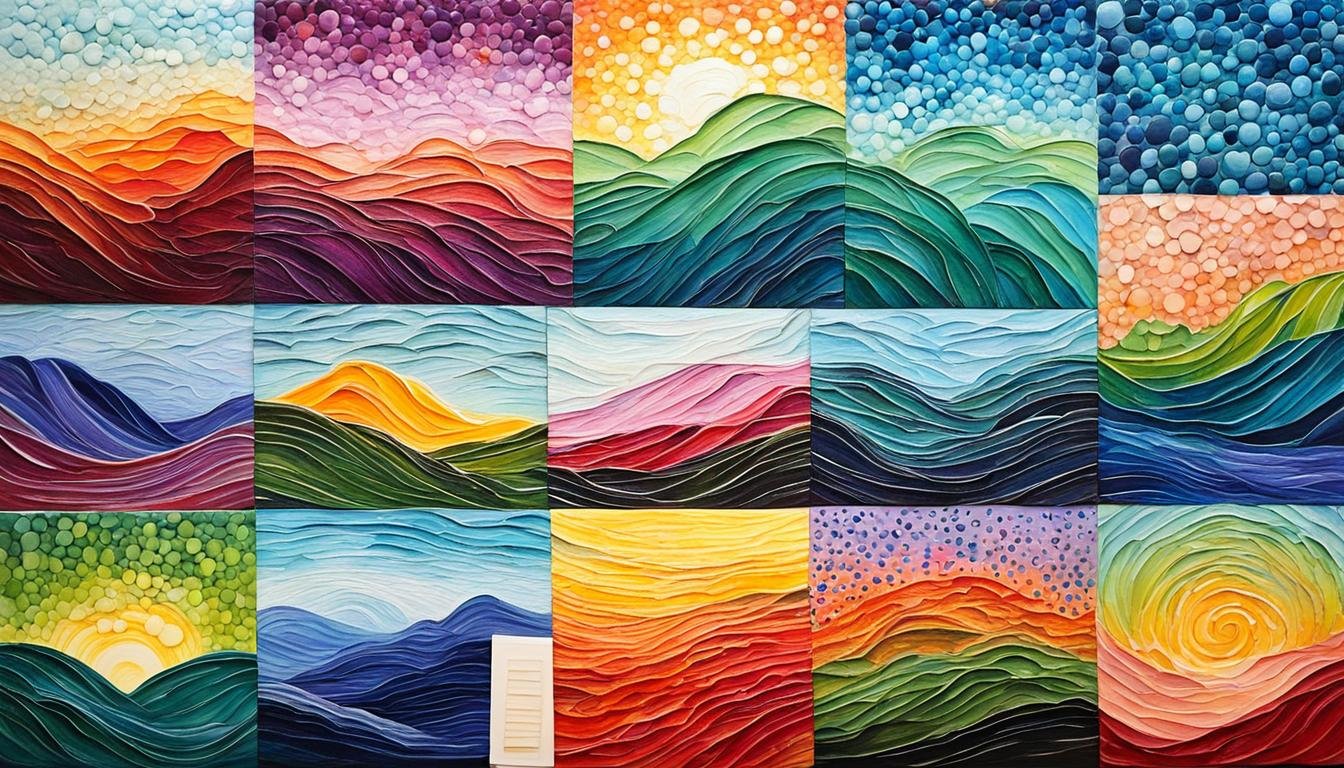Starting to paint can be both exciting and a bit scary. There are so many colors, textures, and ways to express yourself. But, with the right techniques, you can make a blank canvas come alive with your ideas.
This guide will show you 10 key painting techniques. They will help you improve your skills and find your unique style. Whether you like watercolors, oils, or acrylics, these techniques will make your painting better. You’ll learn how to use brush strokes and mark-making to enhance your art.
Key Takeaways
- Discover 10 essential painting techniques to enhance your artistic expression
- Develop your skills and find your unique painting style
- Learn techniques for working with different media, including watercolor, oil, and acrylic
- Explore methods to create texture, depth, and vibrant colors in your paintings
- Gain confidence in your painting abilities and unleash your creativity
Introduction
If you want to get better at painting, learning basic painting techniques is key. These methods let you try out various styles and find what makes you unique. Over time, artists have explored new ways to paint, like thick brushstrokes or bold strokes.
Trying new things and being open can really pay off. It helps you grow as an artist and find new ways to express yourself. By trying out different painting techniques, you can make the most of your artistic expression and creative practice. You can also experiment with styles that feel right to you.
Embracing Spontaneity
Painting lets you be spontaneous and forget about what others think. Techniques like drip painting and splash-painting let the paint take the lead. This creates unique and lively art that shows the moment.
Letting chance and instinct into your creative practice opens up new ways to artistic expression. It also brings out painting techniques that break the rules.
“The act of painting is about discovery – the revelation of what is on the canvas through the act of painting itself.”
– Helen Frankenthaler, American abstract expressionist painter
Acrylic Wash and Ink
Discover the power of acrylic wash and acrylic ink to add depth and movement to your art. Mix acrylic paint with water to create a wash-like effect. This lets the colors underneath show through, adding depth and interest.
Try using high-flow acrylics and spray water on your canvas for more effects. This lets you make big brushstrokes and layer colors slowly. It’s a fun way to play with the paint’s fluidity and build up your art’s layering and depth.
| Brush Type | Percentage Usage |
|---|---|
| Filbert | 35% |
| Flat | 25% |
| Round | 20% |
| Liner | 10% |
| Fan | 5% |
Explore more with acrylic wash and acrylic ink by trying these techniques:
- Layering washes for depth and transparency
- Using ink for bold strokes that show movement
- Mixing wet and dry brushwork for texture
- Letting the paint “bleed” for a unique effect
“Acrylic wash and ink let me make art that’s striking and touching. The layers and brushwork add a sense of spontaneity and energy.”

Use acrylic wash and acrylic ink to open up new creative paths. They help you develop a unique style that grabs people’s attention. Dive into the fluidity and explore new ways to express yourself.
Oil Painting Glaze
Take your oil paintings to the next level with glazing. This method boosts the luminosity, depth, and vibrancy of your work. It’s easy to do by adding a thin, clear layer of oil painting glaze over a dry base. This lets you control the color richness and balance of your painting.
Choosing the right paints is key to glazing. Use high-quality, slow-drying oil colors like Mars Black or Ivory Black. They work great for this technique. With a soft-bristled brush, you can adjust the glaze’s strength. This way, you can layer your paint to get the perfect depth and luminosity.
“Glazing is a game-changer for oil painters. It’s the secret to unlocking the true vibrancy and depth of your colors.”
Glazing brings colors together smoothly, making your painting look unified and harmonious. Let the vibrancy and color richness of this technique make your paintings glow with a beautiful finish.
10 Essential Painting Techniques for Beginners for your home
Looking to change up your living space or add a personal touch outside? This guide covers 10 key painting techniques to help you get pro-like results at home. You’ll learn about acrylic washes, oil painting glazes, and more. These methods add depth, texture, and interest to your work, making your spaces stand out with your style.
Painting is versatile and full of creative potential. Here are the top techniques you should know:
- Palette Knife Work: Use a palette knife for bold strokes and unique textures. It’s great for adding depth to your art.
- Dry Brushing: Drag a dry brush over the canvas for a weathered look. It’s perfect for landscapes or adding flair to walls.
- Sgraffito: Scratch through paint layers to show off the colors underneath. This creates intricate patterns that add depth to your art.
- Acrylic Pouring: Try pouring fluid acrylics onto the canvas for abstract designs. Tilt the canvas for cool effects.
- Gestural Painting: Let your feelings flow through expressive brushstrokes. Capture movement and energy in your art.
| Painting Technique | Description | Best Suited For |
|---|---|---|
| Palette Knife Work | Bold, textured strokes and unique paint applications | Adding depth and dimension to paintings |
| Dry Brushing | Lightly dragging a dry brush across the canvas | Creating a weathered, scratchy effect for landscapes or interior walls |
| Sgraffito | Scratching through layers of paint to reveal underlying colors and textures | Producing intricate patterns and designs with visual depth |
| Acrylic Pouring | Pouring fluid acrylic paints directly onto the canvas and tilting the surface | Creating mesmerizing, abstract compositions |
| Gestural Painting | Free, expressive brushstrokes capturing movement and energy | Unleashing emotions and dynamic expressions in paintings |
Use these painting techniques to make your home special. Let your inner artist shine and turn your spaces into masterpieces. Paint is powerful, and it opens up a world of creativity for you.

Mark-Making and Patterns
Exploring mark-making and patterns in painting is thrilling. These techniques bring texture and visual interest to your art. With Caran d’Ache crayons and oil sticks, you can create amazing effects.
Try different lines like thick and thin ones. These marks show emotion and energy. They make your art dynamic and engaging.
Using repetitive shapes, lines, or colors helps with design. It brings balance and harmony to your paintings.
- Explore the textural qualities of Caran d’Ache crayons and oil sticks to add depth and interest to your work.
- Experiment with patterns and repetition to create visually striking compositions.
- Play with the interplay of light and shadow to enhance the visual impact of your paintings.
Using mark-making and patterns opens up new creative possibilities. It lets you express yourself artistically. Let your creativity flow as you paint, making a piece that touches the senses.
Drip Paint and Splash-Paint
Let your artistic side shine with drip painting and splash-painting. These techniques, inspired by Jackson Pollock, let paint flow freely onto the canvas. Pollock changed art with his drip paint method, focusing on the act of painting and the artist’s connection to the medium.
Drip painting is about controlling paint flow to make unique patterns and textures. You can change the paint’s thickness and amount to get different effects. Try spraying, flicking, or throwing paint to add chance and spontaneity to your art.
This type of painting brings depth and texture to your work, showing the raw energy of creating art. Let your painting grow naturally, letting the paint move on its own. Explore Jackson Pollock-inspired techniques to open up new ways to express yourself.

“Painting is not about making a picture, it’s about the experience.”
– Jackson Pollock
Palette Knife Work
The palette knife is key for adding depth and texture to abstract paintings. It lets you spread paint thickly, making ridges and sharp shapes. These features make your work feel real and inviting.
The author has used palette knives for over thirty years. They’ve shown their work in two shows and many group exhibitions. They started using them at 15 and have collected knives from a teacher and their mom.
Palette knives aren’t just for art. The author has tried using kitchen tools, gardening trowels, and beauty items. These items add new textures and effects to their work.
| Palette Knife Pricing | Blade and Handle Considerations |
|---|---|
| Palette knives can cost from $60 to over $1,000. The author says a smooth, stainless steel blade is best for cleaning. | They like handles that are light and comfy. They try out different types to see what works best for them. |
The author has used brands like Talens and Holbein for their quality. These knives help them try many techniques, like blending colors and making lines.
For adding depth and texture to abstract paintings, the palette knife is a great choice. With its versatility and the author’s experience, you can unlock new creative possibilities.
Gesture Marks and Collage
Unlock your artistic side with gesture marks and collage. Use quick, expressive strokes to catch your subject’s essence. This brings energy and immediacy to your art. Gesture marks add movement and life to your work.
Collage adds texture and depth with elements like fabric or torn magazine pages. These additions make your art more interesting and complex. They let you try new things and make your style unique.
Expressive Strokes and Mixed Media
Try different materials and techniques to boost your creativity. Mix gesture marks with collage for paintings full of texture, depth, and energy. Let your brush or pencil move freely to create a stunning, mixed media piece.
“The purpose of art is to make objects ‘unfamiliar,’ to make forms difficult, to increase the difficulty and length of perception.” – Viktor Shklovsky, “Theory of Prose”
Using gesture marks and collage can take your painting to new heights. They bring spontaneity, texture, and depth to your work. Let your creativity run wild with these techniques.
Conclusion
Learning different painting techniques can open up new creative possibilities and help you find your unique style. By trying new methods like acrylic washes, oil painting glazes, mark-making, and palette knife work, you can change how you approach art. This makes your paintings richer in texture, depth, and emotion.
Keep exploring and finding new painting techniques to improve your skills and express your artistic vision. This can make your home decor more beautiful with unique, eye-catching artwork. Whether you’re just starting or have been painting for a while, these techniques can inspire you to try new things and show your full artistic potential.
So, enjoy experimenting, let your creativity shine, and see what painting can offer. Your artistic journey is just starting, and there are many chances for growth, self-expression, and deep artistic exploration ahead.


